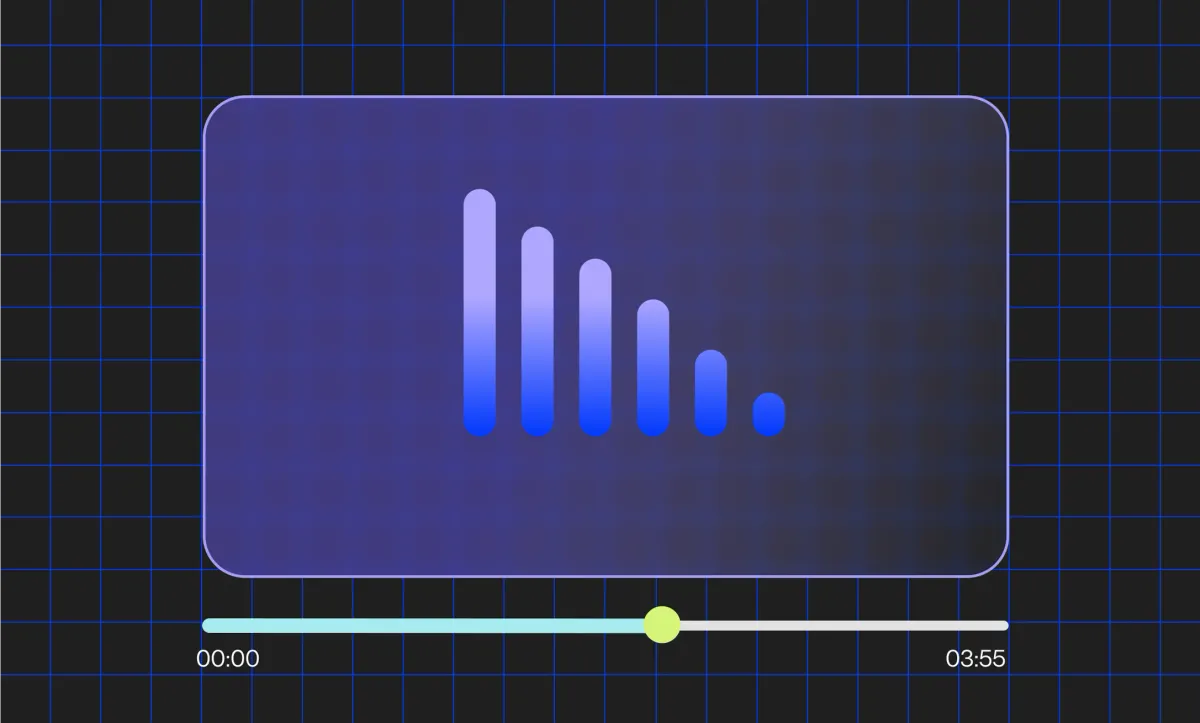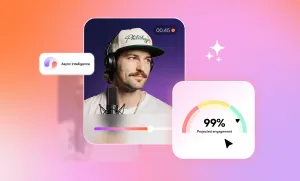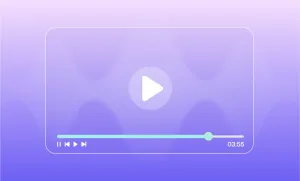You post a video. Views spike. And then you open the analytics and see it: the audience retention line drops off a cliff at second 12.
That moment is brutal, but trust us, it’s not because you “made a bad video,” but because holding attention nowadays feels almost impossible.
You’re editing for people who decide in the first swipe whether you’re worth their time. You’re competing with shorts, reels, podcasts, livestreams, 10-second storytimes, and whatever just went viral five minutes ago.
Everything is fast and everything is replaceable.
Audience retention used to be “nice to have.” Now it’s the whole game. Platforms boost videos that keep viewers watching, and quietly bury the ones that don’t. That means if you can’t hold attention with your storytelling, you don’t just lose a viewer: you lose reach, you lose momentum, you lose the chance to grow.
In short, audience retention isn’t just a metric anymore. It’s the score the algorithm uses to decide if you get seen at all.
Let’s talk about why it matters, why it’s getting worse, and why it feels harder than ever to keep people watching.
TL;DR / Key takeaways
• Audience retention is everything now: if you can’t hold viewers past the first 5–10 seconds, the platform stops pushing your video.
• On YouTube, ~50% average view duration on long-form (60%+ is great) and 70–85%+ completion on Shorts are strong retention signals.
• People usually drop off because of slow intros, unclear value, flat pacing, or weak audio/visual clarity, not because the topic is bad.
• To keep people engaged, hook fast, move visually, pay off often, and deliver what the title/thumbnail promised right away.
• Creator burnout is real: constantly editing for retention, not creativity, makes you feel exhausted and “less good” over time.
• The future is smarter video editing for engagement, tools that learn from audience behavior so you don’t have to keep guessing what works.
What is a good audience retention on YouTube?
Audience retention on YouTube is the percentage of a video that viewers actually watch, averaged across all viewers. YouTube tracks this as a timeline graph that shows how many people are still watching at each moment, including how many are still with you after the first 30 seconds, where most drop-offs happen.
This % watched (also called “average percentage viewed”) is one of the core signals YouTube uses to judge if a video is engaging and worth recommending to more people, because it proves you can hold attention.
Now, what counts as “good” audience retention depends on format and length, but here’s what most YouTube strategists and platform data line up around in 2025:
1. Long-form YouTube videos (5+ minutes)
• If viewers, on average, watch at least half of your video, you’re in a healthy zone. Many YouTube growth coaches and analytics tools treat ~50% average audience retention as “strong” for longer videos.
• Hitting 60%+ average retention on a longer video is considered excellent. That level of retention is a strong signal to the algorithm that people aren’t just clicking, they’re staying.
Why this matters: when you can keep half the audience through the midpoint (or beyond), YouTube is more likely to push that video to new viewers because it predicts that new viewers will also stick. Retention directly feeds distribution.
Keep in mind, the average watch time on YouTube sits around 2–3 minutes, even for longer videos. That’s why YouTube editors obsess over pacing, quick cuts, and opening hooks, not because they want to, but because every second counts.
2. Short-form / Shorts (under ~60 seconds)
• Short-form is graded harsher. On YouTube Shorts, YouTube heavily favors videos where people watch a very high percentage of the clip, often 70%+, and in top-performing cases 80–85% or more.
• In plain English: if most viewers almost finish or fully finish your Short, that’s a strong Shorts signal. A 30-second Short that gets ~85% watch duration will usually beat a 60-second Short that only holds ~50%.
This is why looping, tightly paced Shorts tend to get surfaced more: high completion and rewatch behavior inflate audience retention and tell the system “don’t scroll past this.”
3. The Hook / First 30 seconds
• YouTube specifically calls out the “Intro” metric: what % of viewers are still watching after the first 30 seconds. A strong intro means your title and thumbnail matched the actual content and people felt rewarded, not clickbaited.
• Practical benchmark: keeping ~50–70% of viewers still watching at the 30-second mark is considered really solid, especially for videos longer than five minutes. Creators who keep 70% of viewers through that first minute are generally seen as having a winning hook.
This early retention is make-or-break. If you lose people immediately, YouTube assumes future viewers will also bail and will stop testing the video as aggressively.
So… give me the number
If you want one line you can screenshot and tape above your desk:
A “good” audience retention on YouTube usually means ~50% average view percentage for long-form videos, 60%+ if you’re aiming to outperform, and 70%+ (or higher) completion for Shorts-style content.
Here’s why that bar is actually high: most videos on YouTube do not hold half their audience all the way through. Industry analyses of YouTube performance show that many videos lose most viewers by the midpoint, and only a minority of uploads ever cross the 50% average retention mark.
In other words, if you’re consistently hitting ~50%+ retention, you are already above what most videos achieve.
Still, unfortunately, what keeps one audience glued might bore another. That’s the exhausting truth behind video editing for engagement: creators are editing for attention in a 5-second world.
Creator burnout: What it is and how to fix it
If you’ve ever stared at a timeline full of clips at 2 a.m., wondering why your edit still doesn’t feel right, you’ve experienced the emotional weight behind creating for audience retention.
What creator burnout actually is: psychologically speaking, not just “I’m tired”
Creator burnout is basically the creator economy version of clinical occupational burnout. The World Health Organization defines burnout as a work-related stress syndrome with three parts: (1) exhaustion, (2) growing mental distance or cynicism toward the work, and (3) feeling less effective at it.
It’s officially defined as the result of “chronic workplace stress that has not been successfully managed,” and it’s considered an occupational phenomenon, not just a mood.
When you map that to creators, it fits almost too well. Creator burnout is when filming, editing, posting, optimizing, and “being on” stops feeling like expression and starts feeling like surveillance. You’re still producing, but you feel emotionally flat, irritated at your own audience, and quietly convinced you’re getting worse.
That loss of perceived ability, “maybe I’m not interesting anymore,” is part of the burnout profile, not a personal failure.
Why creator burnout is exploding right now
This isn’t rare.
Recent research on working creators shows that more than half of creators say they’ve experienced burnout specifically because of the job, and over a third have seriously thought about walking away from content altogether.
Why? Because making content in 2025 is not “post a video and chill.” It’s writing, performing, editing, cutting for Shorts, repackaging for Reels, managing brand deals, staying “authentic,” answering DMs, and watching audience retention graphs like a heart monitor.
And the algorithm quietly tells you that if people drop at second 11, you don’t just lose a view , you lose distribution. That constant pressure to hold attention is exactly the kind of chronic, unmanaged stress load that predicts burnout.
There’s also an identity hit.
In most jobs, if a campaign underperforms, the campaign failed. For creators, if a video underperforms, you failed. Your face is the product. Your voice is the product. Your energy is the product. That intimacy is powerful for growth, and brutal for mental distance. It makes “cynicism toward the job,” which the WHO lists as a burnout marker, feel almost like cynicism toward yourself.
How to fix creator burnout (in a way you can actually keep doing)
Psychology research on burnout gives one consistent answer: you recover by changing the ratio between demands and resources. You don’t have to “care less” about your work. You have to make the work cost less per video.
Here’s what that looks like for creator burnout in practice:
• Reduce decision load, not output. Most creators aren’t burned out from creating — they’re burned out from reinventing. Build repeatable structures: a familiar hook format, a consistent edit pace, a recurring series style. You’re still making new content, but you’re not solving 20 creative problems from scratch every single time.
• Take back one area of control. Burnout spikes when everything feels external and random. Pick one thing that’s yours: your upload rhythm, your boundaries on DMs, the hours you’re allowed to film, or what type of brand work you’ll say yes to. Even small control lowers that “I’m at the mercy of the feed” panic that creators describe.
• Schedule recovery like deliverables. This sounds corporate, but it’s survival: breaks only work if they’re planned, not punished. Tell your audience you’re off Saturdays, or that you’re posting in seasons. Viewers adapt. Platforms adapt. Your nervous system doesn’t adapt if you never drop out of “perform now” mode.
• Add support instead of squeezing harder. Burnout research keeps coming back to this: high-pressure work becomes sustainable when you’re not doing it alone. That can mean an editor for first cuts, a collaborator for scripting, or tools that auto-handle repetitive edits and retention tweaks so you’re not manually chasing every 10-second dip.
The point is: creator burnout is not you being “weak.” It’s a recognized stress pattern. The numbers show it’s hitting most creators, not a few unlucky ones.
If you feel exhausted, detached from your own audience, and convinced you’re “losing your touch,” that’s not you falling off, that’s literally the clinical profile of burnout applied to creator work.
Finally, a great way to avoid creator burnout would be to have a simple cheat-sheet on how to keep your audience engaged. That’s why, we’ve also included a quick list of tips on video editing for engagement that can help you boost your video retention rate and keep people from dropping off early.
How to keep an audience engaged
Improving audience retention is possible when you understand why viewers drop off and how to design your videos for real engagement.
Why viewers drop off videos
Most viewers don’t leave because they dislike your content. They leave because their attention is pulled somewhere else. Common drop-off triggers include:
• Slow or unclear intros: Viewers decide within the first 5-10 seconds whether to stay.
• Lack of context early on: If they don’t understand why they should care, they’ll scroll.
• Inconsistent pacing: Long pauses, filler words, or uneven edits can break flow.
• Weak audio or visual clarity: Distracting background noise or blurry visuals kill focus.
• No emotional payoff: People stay for emotion, laughter, surprise, insight, or awe.
Every second counts. That’s why creators spend so much time trimming, reordering, and testing, trying to hit that perfect flow that keeps viewers watching longer.
Attention span and video content
Studies show the average online attention span is now just a couple of seconds, shorter than ever before. That doesn’t mean long videos can’t work; it means they have to earn every second.
To sustain audience retention, focus on:
• Strong hooks: Start with action, curiosity, or conflict, give viewers a reason to care.
• Visual movement: Change camera angles, zooms, or overlays every few seconds to re-capture focus.
• Micro-narratives: Break long videos into short emotional beats. Each one should feel rewarded.
• Captions and pacing: Add rhythm through text, sound effects, or quick transitions.
Think of it like music, you want flow, repetition, and variation to keep the rhythm alive.
The trust contract with the viewer
Audience retention is built on trust. The title and thumbnail make a promise (“I’ll show you X”). The first 5–10 seconds need to confirm that promise immediately. If the viewer feels baited or stalled, they leave.
If they feel, “Oh, I’m actually getting what I came for,” they’ll stay longer, even in slower moments. This is why clarity beats mystery for most educational and how-to content.
Practical move: say up front what they’ll get and when (“In the next 30 seconds I’ll show you…”). That reduces early drop-off.
Pattern breaks and reward loops
Your viewer’s brain is scanning for reasons to stay or to swipe. Pattern breaks are moments that reset attention: a cut to a new angle, an unexpected visual, a stat on screen, a quick joke, a surprising claim. Reward loops are the feeling of “keep watching, more good stuff is coming.”
You want both:
• Use pattern breaks every few seconds to re-hook attention.
• Use reward loops (“I’ll show you the exact template in a second”) to pull them forward.
When you stack those two intentionally, you’re not just “editing the video,” you’re actively managing attention, which is the core of audience retention.
The hidden cost of “editing for engagement”
The irony? Even when creators know these rules, implementing them takes hours. Every decision, what to cut, when to transition, and how to open comes down to guesswork.
And when it doesn’t perform, the cycle restarts.
Manual editing becomes less about creativity and more about predicting a loop that feeds burnout.
But smarter editing tools are changing that. By learning from audience behavior, they’re helping creators stop guessing what works and start focusing on storytelling again.
The future of audience retention
At its core, audience retention isn’t just a metric. It’s the heartbeat of every creator’s story. It tells you where emotion landed, when curiosity peaked, and when interest dropped.
The goal isn’t to hack it, but to understand it.
And maybe soon, you won’t have to analyze graphs or guess at pacing, because your editing tools will already know what keeps people watching.
Final thoughts
Editing for attention has become every creator’s daily challenge, and it’s easy to see why. Shorter attention spans, endless competition, and algorithm pressure make audience retention harder than ever.
We’ve seen how most viewers drop off within seconds, how burnout creeps in after hours of manual editing, and how guessing what “works” can drain creativity. The struggle isn’t about effort; it’s about uncertainty.
But the next wave of video editing for engagement is changing that. Soon, you won’t have to spend hours trimming and testing; your editing tool will already know what keeps people watching.
Because what if you didn’t have to edit for engagement at all… what if your tool already knew what works?
FAQs
What is a good audience retention rate on YouTube?
A good audience retention rate on YouTube means that at least 50% of viewers stay until the halfway point of your video. Anything above that is considered strong by platform standards. However, the ideal percentage depends on your niche and video length, as shorter videos tend to have higher retention. The key is to focus on pacing, storytelling, and early hooks that keep people curious from the first few seconds.
Why do viewers drop off videos so quickly?
Viewers often drop off because of slow intros, unclear value, or pacing that doesn’t match their expectations. Even good content can lose traction if it takes too long to get to the point. In today’s 5-second attention world, first impressions are everything. Clear structure, strong openings, and emotional payoffs throughout your video help maintain video retention rates and keep audiences from scrolling away too soon.
How can I keep my audience engaged throughout a video?
To improve audience retention, make your content visually dynamic and emotionally consistent. Use movement, captions, and varied camera angles to keep energy high. Introduce small “mini-stories” or cliffhangers that make viewers want to see what comes next. Avoid filler and prioritize flow. Every cut should add value. Lastly, edit with your audience in mind: what are they here for, and when do they usually lose interest?
What are the biggest video editing pain points for creators?
Most creators struggle with the time-consuming nature of video editing for engagement, reviewing hours of footage, cutting filler, and guessing which version will perform best. It’s also hard to stay objective when you’ve watched your own content repeatedly. This process often leads to creative fatigue and frustration. That’s why creators increasingly turn to AI-powered editing tools that simplify decision-making and highlight what truly connects with viewers.
How does creator burnout affect content quality?
Creator burnout impacts both motivation and creativity. When you’re constantly editing for retention, it’s easy to lose perspective and joy in the process. Burnout can lead to rushed uploads, inconsistent posting, or repetitive ideas. Taking breaks, reusing strong content, and adopting smarter workflows can help. Ultimately, creators need tools and habits that reduce manual stress, freeing up energy to focus on storytelling rather than just survival.








